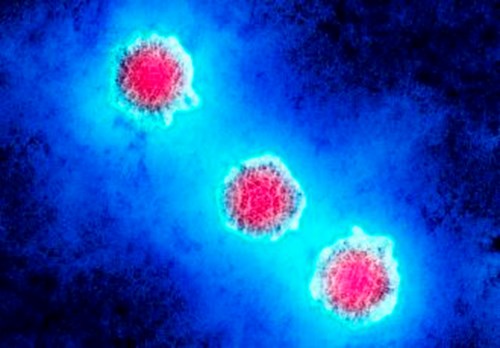Herpes Simplex Virus 1

HSV-1 is responsible for oral herpes which is endemic globally with over 3 billion people under age 50 living with the infection [1].
The presence of cold sores or ulcers around the mouth is a common characteristic of oral herpes. Most infections however are asymptomatic. Similar blisters around the genital area are usually observed with genital herpes primarily caused by Herpes Simplex Virus 2 (which shares only about 50 percent genomic homology with HSV-1) [2]. HSV-1 as well as other herpesviruses can also establish latent infections in the human host.
Although HSV-1 is mainly transmitted via the oral route, changes in human sexual behaviour has caused an increase in HSV-1-associated genital herpes [3]. Transmission between mother and infant (neonatal herpes) during delivery is rare and can be severe [4]. Other complications including aseptic meningitis and keratitis may also arise in immunocompromised hosts [1,5].
As HSV-1 infection can be painful, unsightly, and highly contagious through close-contact transmission, there is significant interest in developing control measures including antivirals and vaccines. Acyclovir, famciclovir and valacyclovir are three nucleoside analogues used in treatment. Acyclovir is also used for prophylaxis. These antivirals reduce symptom severity rather than eliminate the virus. Drug resistance has also been reported especially among immunocompromised patients undergoing long-term anti-viral therapy [6]. Research is underway to develop vaccines for herpes prevention [5].
NCPV has various HSV strains in the collection to support scientific research into the development of novel therapeutics and vaccine candidates. More contemporary strains with antiviral sensitivity data are being accessioned and will be available shortly.
Written by Okechukwu Onianwa
References:
1, World Health Organization (2017). Herpes simplexvirus. Available from: https://www.who.int/news-room/fact-sheets/detail/herpes-simplex-virus. Accessed 5th April 2020.
2, Whitley, R. J., (1996) Herpesviruses. In: Baron S, editor. Medical Microbiology. 4th edition. Galveston (TX): University of Texas Medical Branch at Galveston. Available from: https://www.ncbi.nlm.nih.gov/books/NBK8157/
3, Wald A. (2006). Genital HSV-1 infections. Sexually transmitted infections, 82(3), 189–190.
4, National Health Service (2018). Neonatal herpes (herpes in a baby). Available from: https://www.nhs.uk/conditions/neonatal-herpes/. Accessed 5th April 2020.
5. Centers for Disease Prevention and Control (2017). Genital Herpes – CDC Fact Sheet (Detailed). Available from: https://www.cdc.gov/std/herpes/stdfact-herpes-detailed.htm#ref11. Accessed 5th April 2020.
6, Jiang, Y. C. et al (2016). New strategies against drug resistance to herpes simplex virus. International journal of oral science, 8(1), 1–6.
